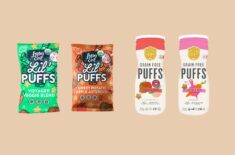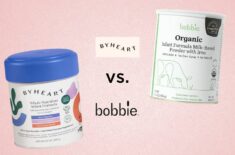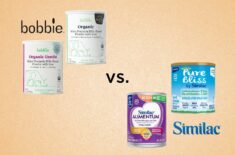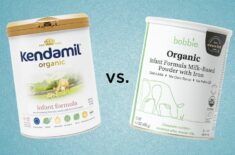Overview
Critical brain development and growth happen from birth to two years of age. But with most children eating only small amounts of food, it’s important to make every bite count.
The US Dietary Guidelines Advisory Committee recommends giving your child nutrient-rich foods to complement breastfeeding or infant formula when they’re ready. (1)
So, let your child eat a variety of foods from all food groups, avoiding added sugars and junk food.
Baby-led weaning can be a good way to encourage your child to develop healthy eating habits. They get to try different tastes and textures while sharing family meals.
Instead of starting with purées or baby food jars like Little Spoon and Yumi, you give your child some finger foods to try from the beginning.
But if they’re eating like the rest of the family, can you give them ice cream and peanut butter, too? How about cucumber, scrambled eggs, watermelon, and yogurt? What finger foods can you give your 6-month-old? Is it OK to switch from purées to BLW?
You’ll find answers to these questions below, plus more information about what to feed your child and the best time to start.
What’s BLW?
BLW (baby-led weaning) is a feeding approach conceptualized by Dr. Gill Rapley in 2001. (2)
It’s about offering your baby healthy foods they can grasp and self-feed while sharing mealtimes with the rest of the family.
It can help hone your child’s fine motor skills, hand-eye coordination, appetite control, and independence.
The benefits of baby-led weaning can even include learning decision-making skills because your child gets to decide what food they prefer (from the foods you prepare) and they’ll also eat it at their own pace.
What Age Is Appropriate For Baby-Led Weaning?
BLW pioneer Dr. Rapley recommends waiting until your child is six months old before starting them on this feeding approach. It can help ensure that your little one is truly ready to eat solid foods. (3)
But she also acknowledges that some children may already show signs of readiness at four months.
Dr. Rapley says that sitting upright is an important sign, especially for baby-led feeding.
These can also be cues that your child is ready for solids:
- Good neck strength
- Leaning forward or opening their mouth when they see food
- Swallowing or moving food to the back of their mouth
- Reduced tongue-thrust reflex (involuntary action of pushing tongue out when you put something in their mouth)
What Finger Foods Can I Give My 6-Month-Old?
You can start baby-led weaning with finger foods that are soft enough for your 6-month-old child to swallow without choking. But these foods should also be firm enough for them to hold.
At this age, kids use their palms to grasp things.
Cut food large enough for your child to hold one part while nibbling on the other end.
You can start them on the following finger foods:
- Sliced bananas
- Sliced avocados
- Steamed carrot strips
- Steamed, peeled apple slices
- Steamed broccoli florets
- Steamed zucchini or summer squash strips
- Steamed beet strips
- Baked or steamed sweet potato or butternut squash fries
- Hard-boiled eggs, quartered
- Shredded chicken
- Shredded beef
- Low-mercury fish, with bones removed
Allergenic Foods
When Can Babies Have Scrambled Eggs?
You can give eggs (including scrambled eggs) when your baby is ready for solid foods from around four to six months.
Parents were advised to delay giving common food allergens like eggs, peanuts, and milk in the past. (4)(5)
But studies trials show that early introduction when your child is around six months old can help prevent future incidents of food allergies. (4)(5)
Still, be sure to ask your pediatrician’s advice before giving eggs to your baby.
Make sure to cut scrambled eggs into small squares or strips appropriate for their age to reduce choking risks.
When Can Babies Eat Pancakes?
You can serve pancakes anytime your child is developmentally ready for solid foods. It can be from around four to six months.
Cut up pancakes into strips or small squares appropriate to their age.
However, be careful if your pancakes contain gluten/wheat, dairy, or eggs as these are considered top allergens.
Consult with your pediatrician before introducing your baby to these potential allergens.
You can also opt for gluten-free, dairy-free, and egg-free pancakes and recipes.
Can A 6-Month-Old Have Yogurt?
Yes, yogurt is a soft food item ideal for spoon-fed or BLW infants. It’s not a choking hazard.
In BLW, you can let your child dip their finger into yogurt and put it in their mouth. Another option is to make it a dip for your child’s finger foods.
Milk and other dairy products, including yogurts, butter, and cheese, are potential allergens. (6)
Early introduction to yogurt (at around six months old) might help your child reduce the risk of allergic incidents in the future. (4)(5)
But consult your pediatrician or a dietitian for concerns about offering yogurt to your child.
Can You Put Butter On Toast For A 6-Month-Old?
Yes. You can offer your 6-month-old child butter on toast if they aren’t allergic to milk. Though it may contain fewer milk proteins, butter is still a dairy product. Trace amounts of milk proteins might still trigger an allergic reaction in some babies. (7)
If your child has known allergies to milk, be sure to consult with your doctor before putting butter on their toast.
Consult your baby’s pediatrician if you plan early introduction of this possible allergen (dairy). (4)(5)
You can also try spreading ghee or coconut oil on toast. Ghee tends to have even less milk solids than butter. Opt for organic and grass-fed choices of either whenever possible.
Toast with just the bread or other toppings, such as toast with mashed avocado, can be a good BLW food. Just make sure the bread isn’t tough to avoid choking risks.
Is Peanut Butter Good For A Baby?
Yes. Peanut butter can be good for your baby, but only if they don’t experience allergic reactions to this common food allergen.
Still, studies show that peanuts can be best introduced at six months of age for children. Doing this can prevent peanut allergy development. (4)(5)
You can follow these guidelines from NIAID (National Institute of Allergy and Infectious Diseases) for peanut allergen introduction: (8)
- Guideline 1, high-risk babies (known egg allergy and/or severe eczema, skin allergy condition characterized by red and/or itchy skin) – peanut allergen introduction at 4-6 months
- Guideline 2, babies with mild or moderate eczema – peanut allergen introduction at around six months of age
- Guideline 3, babies without eczema or any food allergy – peanut-containing foods can be freely introduced into their diets anytime they’re ready
Be sure to seek your pediatrician’s approval before feeding any peanut-containing foods to your little one.
They might perform allergy tests or send your child to a specialist for other tests, including oral food challenge and/or a skin prick test. (8)
Allergist Dr. Sandra Hong of Cleveland Clinic recommends only giving around 2 tsp of peanut butter (diluted with breast milk, water, or formula) up to three times a week. (9)
If your baby doesn’t show any allergic reaction, Dr. Hong recommends making peanut butter a regular part of their diet.
She adds that a peanut allergy can quickly develop if you skip giving it to your child, even for a few weeks.
Stop immediately and call emergency services if your baby experiences vomiting, rashes, or itching.
It’s important to remember that peanuts can be a choking hazard. Don’t give whole peanuts to your baby. If you’re giving them peanut butter, make sure it’s not chunky and/or too thick.
Fish And Seafood
Some finned fish such as halibut, salmon, and tuna can trigger an allergic reaction. (10)
Seafood and shellfish like crab, shrimp, lobster, oysters, squid, and scallops can also be potential allergens. (11)
Introduce these foods with caution, especially if your child has known allergies to other foods.
What Foods Can I Start With For BLW?
Foods that are soft and easy to swallow are ideal for babies eating solid foods for the first time. But choose healthy ones.
According to Dr. Rapley, providing your child with healthy food options is one of the main components of baby-led weaning. (2)
But you don’t have to worry about giving food in a certain order.
The AAP (American Academy of Pediatrics) explains that there’s no specific order for giving foods for the first time. (12)
They also recommend giving your child different foods to meet their nutrition needs.
But if you’re starting your child on BLW, you can choose soft foods your child can eat on their own.
If you’re unsure, check the food with your hands. It should squish easily between your fingers with minimal pressure, except meat pieces.
The US Dietary Guidelines Advisory Committee recommends offering a variety of foods as your baby’s first foods. (1)
You might have more food choices in baby-led weaning than with the spoon-feeding approach.
Instead of being limited to purées as first foods, you can give them pieces of food they can pick up using their hands. (1)
Utensils aren’t necessary because babies are encouraged to explore food with their fingers. (2)
Meat, Poultry, Fish, And Seafood
- These are iron-rich foods that can also contain protein, zinc, and choline.
- Essential omega-3 and omega-6 fatty acids from seafood are key nutrients for rapid brain development through your baby’s first years of life. (13)
- Some fish, including salmon and trout, are natural sources of vitamin D. (14)
- There are also some fish that contain high levels of mercury, a heavy metal that can have harmful effects on your baby’s brain development. (15)
- Some high-mercury fish to avoid: king mackerel, shark, swordfish, marlin, orange roughy, tilefish, and bigeye tuna. (15)
Meat, poultry, fish, and seafood tend to be harder than fruits and vegetables. That’s why some parents choose to give them when their kids are older and have teeth.
But you can still serve these iron-rich foods from the start in BLW, no matter their age as long as they’re ready for solid foods. (16)
Some safety precautions to remember:
- Ensure that these foods are cooked until tender before giving them to your baby.
- Avoid raw or half-cooked foods because they can cause food-borne illnesses. (17)
- Always check for bones and spines before giving them to your child.
- It might be best to serve meat and chicken on bones (such as drumsticks or ribs) for children around six months old. They can nibble some meat off the bones without the risk of swallowing the entire bone.
- You can also consider ground meat to reduce choking risks but check for broken bones that might be in the mix.
- Fish and some seafood can trigger an allergic reaction in some babies. Introduce with caution to babies with known allergies to other food items. (10)(11)
Vegetables And Fruits
- Most fruits and veggies are packed with plenty of vitamins and minerals.
- Beans, peas, and lentils are good protein and dietary fiber sources.
Some options your baby can try, just make sure they’re all well-cooked and safely prepared:
- Sweet potato
- Apples
- Broccoli florets
- Green beans
- Melon (can be served raw)
- Avocado (can be served raw)
- Whole strawberries (can be served raw)
- Smashed blueberries (can be served raw)
- Orange wedges (tough membranes and seeds removed)
- Pear slices (can be served raw if soft and very ripe, but steamed and peeled if hard)
- Smashed tomatoes
- Banana slices (ideally about 2 fingers’ width)
Hard Fruits & Veggies
Always consider your child’s safety when choosing and preparing their finger foods.
For example, hard fruits and veggies like apples and carrots shouldn’t be served raw, especially for children under one year old. Instead, you can steam them until tender before serving them to your child.
Cut into strips long enough for your child to hold one end and nibble from the other.
Dairy Products
- Milk is a common allergen.
- Don’t give pure cow’s milk before your child is at least 12 months old. But you can introduce your child to yogurt and cheese before they turn one. (1)
Some options to try:
- Plain, full-fat yogurt (regular or Greek-style)
- Mozzarella cheese
- Swiss and cheddar cheese
Be sure to cut cheese into small pieces or strips that are wide enough for your little one to hold because they can be a choking hazard.
Whole Grains
- Iron-fortified barley, multigrains, oats, or infant rice cereals can provide some of your child’s nutrient needs.
- But offer other grain choices before giving rice cereal to your child.
- Rice contains high levels of arsenic, a toxic heavy metal that can cause certain cancers or problems in a child’s brain development. (18)
- Whole grains contain high potassium levels (maintains kidney, bone, and cardiovascular system health) and dietary fiber. (1)
Some options to try:
- Baked oatmeal strips
- Whole-grain toast strips
- Whole-grain pita strips
- Whole-grain English muffin strips
- Whole-grain pancake strips
- Whole-wheat pasta, cooked until tender
Many food items made from grain such as wheat, rye, and barley contain gluten, a common allergen. If your child has gluten intolerance or allergy, you might need to avoid these gluten-containing foods. (19)
Be sure to check the food label.
Also, consult your pediatrician and go over the list of foods your child can eat if they have a gluten allergy.
Many parents opt to feed their kiddos a wide variety of whole, unprocessed foods, especially in their first year of life. The processed options given above should ideally be used as treats not as regular, daily foods.
Is Cucumber OK For Baby-Led Weaning?
Yes. Cucumber can be a great choice for your baby in BLW.
Its outer portion is harder (but not too hard) and can make the strip/slice easier for your baby to hold. But the interior part is softer and might be easier to munch on.
Can Babies Eat Strawberries?
Yes. Strawberries can be a nutritious food to offer in BLW. But make sure to slice it in half or leave it whole before giving your baby. Especially if they are younger.
Can Babies Eat Tomatoes?
Yes. Your child can eat tomatoes. It’s healthy and the bright color might be visually appealing to your baby.
Just make sure you smash it or slice it before giving it to your baby, especially cherry tomatoes, which can be a choking hazard.
When Can Babies Eat Watermelon?
Babies can eat watermelons anytime they’re ready for solid foods. But always ensure to remove the seeds before giving this fruit to your child.
At What Age Can A Baby Try Ice Cream?
The added sugars, processed fats, and additives in ice cream make it a less healthy food option for everyone. But if you want to give ice cream as an occasional treat, be sure to wait until they’re at least one year old.
Frequent consumption of sugar-rich foods is linked to a higher risk of obesity. (20)
Also, make sure your child doesn’t have a dairy allergy before introducing it. You can also opt for dairy-free versions such as those made with cashew or coconut milk.
At What Age Can A Baby Have Pasta?
It’s alright to introduce pasta when your child begins eating solid foods. Depending on their readiness, it can be around four to six months of age.
But make sure to cook pasta until tender.
For children under one year old, it might be best to offer bigger pasta shapes such as penne or rigatoni or flat, wide noodles. Stay away from thinner noodles like spaghetti because they have a higher choking risk.
Some grains like wheat have gluten, which can be allergenic. Avoid these foods and choose gluten-free pastas if your child has known food allergies or if your family follows a gluten-free diet. (19)
Check with your pediatrician before giving foods with gluten to your baby.
Baby Led Weaning and Choking
Foods To Avoid Serving While Doing BLW
Avoid these choking hazards:
- Hot dogs
- Candy
- Nuts and seeds
- Raw carrots or apples
- Whole grapes
- Whole nuts
- Popcorn
- Crackers
- Chunks of thick peanut butter or other nut butters
Other foods to avoid: (1)
- Added sugars
- Added salt
- Cow’s milk (can be difficult for kids under one year old to digest) (21)
- Honey (to avoid a risk of botulism) (1)
- Slippery foods that might be hard for your baby to pick up or hold (which can be frustrating)
Always sit with your little one and watch them eat.
Watch out for signs of choking in BLW, but don’t try to help if they’re gagging. If your baby gags know that it’s normal and can actually help keep them from choking.
How to Cut Foods for BLW
To reduce choking risk, you can also cut foods according to what your child can handle at their age.
Around Four To Eight Months Old
In general, foods for smaller children should be big enough to grasp with their entire palm. They grab food with their palm and bring it to their mouth at this age.
In BLW, they can hold one end of the food while eating off the part that sticks out from their hand.
For Nine Months Old To One Year
At this age, your child might already develop the pincer grasp to pick up foods with their index finger and thumb.
You can prepare small pieces of food for this age range. They can pick up these pieces and put them in their mouth.
But still, watch for choking hazards while your child is eating. Don’t let them put too many pieces at once inside their mouth.
For One Year Old And Above
Your child might already become interested in dining utensils at this age. But you can also continue providing them with finger foods.
Cut food into manageable pieces. The slices can be bigger than those you prepared when they were nine months old.
But continue to watch out for choking hazards like chunks that they might pop into their mouths.
How Much Should A 6-Month-Old Baby Eat?
In general, a child can eat around 4 oz or ½ cup of food per meal, though that depends on many factors, including your child’s age, appetite, and hunger.
How much your baby eats in BLW depends entirely on them. Remember that you have to fully allow your child to take the lead in this feeding approach.
So, you can’t stop them from eating if you think they’ve had enough or trick them into eating more if you believe they ate too little.
According to Dr. Rapley, you can’t even “help” them have some food in their hands or assist in getting that in their mouth. (2)
Will My Baby Actually Eat Much Food With BLW?
Again, in BLW, it’s really up to your baby how much they want to actually eat.
We can’t tell if they’ll even eat anything or a lot. And you can’t also influence their choice.
But Dr. Rapley assures that no matter what your child’s feeding pattern or behavior might be, that can be fine for your child. (22)
She explains that a normally developing, healthy baby who doesn’t appear to eat well might actually be eating enough based on their needs.
“In the second half of their first year the only nutrients most babies begin to need in addition to breastmilk are tiny amounts of iron and zinc.
A few licks or bites (not mouthfuls!) each day from foods rich in these minerals, such as meat and eggs, is almost certainly enough to provide this.
Babies don’t starve themselves – if they are hungry, they will eat. The problem is that our expectations of how much babies should eat tends to be based on the amounts they eat when they’re spoon fed.” (22)
Still, you can consult with your pediatrician for concerns over your child’s nutritional needs while doing BLW.
How Many Meals Should A Baby Eat?
It’s important to follow your baby’s lead. However, Dr. Rapley advocates shared family meals as part of BLW’s feeding concepts.
She says that allowing your child to self-feed but excluding them from family mealtimes isn’t “true” BLW. But you also don’t have to force your child to eat during family meals at all times. (2)
In general, babies around six months old might begin with just one meal a day.
You can slowly increase the frequency to two meals a day when your child is around 8-9 months.
Then, the meals can be within your family’s schedule of three times a day, beginning at 10 months.
But these aren’t absolute rules, mama. You can adjust, depending on your baby’s lead.
Creating A BLW Meal Plan
Many pediatricians and nutrition experts recommend introducing new food to your child from different food groups for different flavors and textures. It might help them avoid becoming picky eaters in the future. (23)
It can be a good idea to create a BLW meal plan so you can schedule what foods to prepare for your child each day.
This can help you plan and space out the same foods so your child can enjoy more variety.
Some phone apps to try:
- BLW Meals: How to Start Solids App
- Baby Led Kitchen App
Can You Switch From Purées To Baby-Led Weaning?
Yes. According to Dr. Rapley, it’s never too late to switch to BLW. But be sure to understand the principles of BLW before making the switch. (2)
Here are some tips that can make the switch easier:
- Learn to trust your baby.
- Don’t be tempted to sneak some food into their mouth. No paper airplanes here, mommy.
- If they’re confused because they’re used to being spoon-fed, you can tell them to try picking up their food and putting it in their mouth.
- But don’t “help” your child if they can’t pick their food up. Let them lead.
- You can also give them some purées, but let them enjoy it in different ways from spoon-feeding.
How to Let Baby Self Feed Purées
- Put some scoops of purée in a small bowl or on their food tray. Let them dip their fingers and put it in their mouth.
- Another option is to teach them how to dip their finger foods into the purée.
- But your child might also have other ideas, like scooping it up. Just let your child enjoy the meal.
Do Babies Need Teeth For Baby-Led Weaning?
No. Gums are surprisingly strong and can help your baby chew their food even if they still don’t have molars.
Drinks & Baby-Led Weaning
Milk Feeds
It’s important to continue giving your child breast milk or formula even if they’re already eating solid foods.
Dr. Rapley reminds parents that baby-led weaning isn’t about replacing milk feeds. Instead, it promotes complementary feeding. (24)
When Can I Introduce Water To My Baby?
Your pediatrician might have other recommendations about water. To be sure, please consult with them before giving water to your baby for the first time.
It may be ideal to give water only when your child is six months old and above. Make sure you give your baby clean, filtered water. Avoid tap water and water that comes from plastic bottles. To avoid the risks of illnesses, you can also boil water and let it cool.
Dairy Products
Avoid whole cows’ milk for children under one year old. These have proteins that can be difficult for their tummies to digest. (21)
Yogurt drinks may be allowed in your baby’s first year, but make sure to consult your doctor if your child has known allergies to cow’s milk proteins and other allergenic foods. (25)
You can also try giving your baby coconut yogurt for a dairy-free alternative.
Fruit Juices & Other Sugary Drinks
Avoid giving any drink with added sugars to your baby. These can increase your child’s risk of obesity. (20)
These can include commercial fruit juices, milkshakes, and fizzy drinks.
Caffeinated Drinks
Don’t give your child caffeinated drinks such as sports drinks, soft drinks, tea, and coffee. There are currently no established safe limits for caffeine in children. (25)
Helpful Tools
- High chair with footrest
- Easy-to-hold spoon and fork (not required)
- Sectioned plate or bowl (not required)
- Bib with catch pocket
- Sleeved bib or smock
- Open lid or sippy cup
- Easy-to-clean mat to cover the floor
- Cutting tools
- Baby wipes (for clean up)
REFERENCES
(1) https://www.dietaryguidelines.gov/sites/default/files/2020-12/Dietary_Guidelines_for_Americans_2020-2025.pdf
(2) http://www.rapleyweaning.com/assets/Defining_BLW_v2.pdf
(3) http://www.rapleyweaning.com/assets/How_early_is_too_early.pdf
(4) https://www.ncbi.nlm.nih.gov/pmc/articles/PMC4046529/
(5) https://pubmed.ncbi.nlm.nih.gov/20920771/
(6) https://www.mayoclinic.org/diseases-conditions/milk-allergy/symptoms-causes/syc-20375101
(7) https://www.foodallergy.org/living-food-allergies/food-allergy-essentials/common-allergens/substitutions/butter-substitutions
(8) https://www.nih.gov/news-events/news-releases/nih-sponsored-expert-panel-issues-clinical-guidelines-prevent-peanut-allergy
(9) https://health.clevelandclinic.org/should-i-really-start-giving-my-4-month-old-baby-peanut-butter/
(10) https://acaai.org/allergies/allergic-conditions/food/fish/
(11) https://www.mayoclinic.org/diseases-conditions/shellfish-allergy/symptoms-causes/syc-20377503
(12) https://www.cdc.gov/nutrition/infantandtoddlernutrition/foods-and-drinks/when-to-introduce-solid-foods.html
(13) https://www.ncbi.nlm.nih.gov/pmc/articles/PMC7697719/
(14) https://www.ncbi.nlm.nih.gov/pmc/articles/PMC2698592/
(15) https://www.epa.gov/fish-tech/epa-fda-advice-about-eating-fish-and-shellfish
(16) http://www.rapleyweaning.com/assets/Iron.pdf
(17) https://www.cdc.gov/foodsafety/foods-linked-illness.html
(18) https://www.fda.gov/food/metals-and-your-food/arsenic-food-and-dietary-supplements
(19) https://celiac.org/gluten-free-living/what-is-gluten/sources-of-gluten/
(20) https://www.ncbi.nlm.nih.gov/pmc/articles/PMC6959843/
(21) https://www.ncbi.nlm.nih.gov/pmc/articles/PMC2791650/
(22) http://www.rapleyweaning.com/assets/My_baby_isn’t_a_good_eater.pdf
(23) https://www.mayoclinic.org/healthy-lifestyle/childrens-health/in-depth/childrens-health/art-20044948
(24) http://www.rapleyweaning.com/assets/Breastmilk_vs_solids.pdf
(25) https://www.cdc.gov/nutrition/infantandtoddlernutrition/foods-and-drinks/foods-and-drinks-to-limit.html












